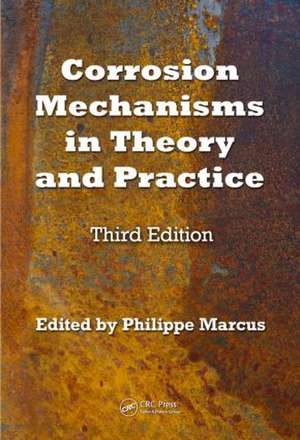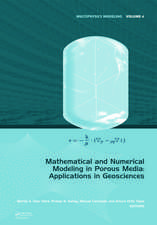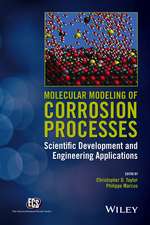Corrosion Mechanisms in Theory and Practice: Corrosion Technology
Editat de Philippe Marcusen Limba Engleză Hardback – 18 aug 2011
Revised and expanded, this edition includes four new chapters on corrosion fundamentals, the passivity of metals, high temperature corrosion, and the corrosion of aluminum alloys. The first half of the book covers basic aspects of corrosion, such as entry of hydrogen into metals, anodic dissolution, localized corrosion, stress corrosion cracking, and corrosion fatigue. Connecting the theoretical aspects of corrosion mechanisms to practical applications in industry, the second half of the text discusses corrosion inhibition, atmospheric corrosion, microbially induced corrosion, corrosion in nuclear systems, corrosion of microelectronic and magnetic data-storage devices, and organic coatings.
With contributions from leading academic and industrial researchers, this bestselling book continues to provide a thorough understanding of corrosion mechanisms—helping you solve existing corrosion challenges and prevent future problems.
| Toate formatele și edițiile | Preț | Express |
|---|---|---|
| Paperback (1) | 745.89 lei 6-8 săpt. | |
| CRC Press – 16 mai 2017 | 745.89 lei 6-8 săpt. | |
| Hardback (1) | 2519.52 lei 6-8 săpt. | |
| CRC Press – 18 aug 2011 | 2519.52 lei 6-8 săpt. |
Preț: 2519.52 lei
Preț vechi: 3072.58 lei
-18% Nou
482.12€ • 525.80$ • 406.52£
Carte tipărită la comandă
Livrare economică 24 aprilie-08 mai
Specificații
ISBN-10: 1420094629
Pagini: 942
Ilustrații: 570 black & white illustrations, 59 black & white tables
Dimensiuni: 178 x 254 x 58 mm
Greutate: 1.86 kg
Ediția:Revizuită
Editura: CRC Press
Colecția CRC Press
Seria Corrosion Technology
Public țintă
ProfessionalCuprins
Fundamentals of Corrosion (Surface Science and Electrochemical Basis), Hans-Henning Strehblow and Philippe Marcus
Surface Effects on Hydrogen Entry into Metals, Elle Protopopoff and Philippe Marcus
Anodic Dissolution, Michel Keddam
Thin Oxide Film Formation on Metals, Francis P. Fehlner and Michael J. Graham
Passivity of Metals, Hans-Henning Strehblow, Vincent Maurice, and Philippe Marcus
Passivity of Austenitic Stainless Steels, Clive R. Clayton and lngemar Olefjord
Mechanisms of Pitting Corrosion, Hans-Henning Strehblow and Philippe Marcus
Sulfur-Assisted Corrosion Mechanisms and the Role of Alloyed Elements, Philippe Marcus
Further Insights on the Pitting Corrosion of Stainless Steels, Bernard Baroux
Crevice Corrosion of Metallic Materials, Pierre Combrade
Stress-Corrosion Cracking Mechanisms, Roger C. Newman
Corrosion Fatigue Mechanisms in Metallic Materials, Thierry Magnin
High Temperature Corrosion, Michael Schütze
Corrosion Prevention by Adsorbed Organic Monolayers and Ultrathin Plasma Polymer Films, Michael Rohwerder, Martin Stratmann, and Guido Grundmeier
Atmospheric Corrosion, Christofer Leygraf
Corrosion of Aluminum Alloys, Nick Birbilis, T.H. Muster, and R.G. Buchheit
Microbially Influenced Corrosion, Dominique Thierry and Wolfgang Sand
Corrosion in Nuclear Systems: Environmentally Assisted Cracking in Light Water Reactors, F.P. Ford and P.L. Andresen
Corrosion of Microelectronic and Magnetic Data-Storage Devices, Gerald S. Frankel and Jeffrey W. Braithwaite
Organic Coatings, J.H.W. de Wit, D.H. der Weijde, and G. Ferrari
Index
Notă biografică
Philippe Marcus is director of research at CNRS and director of the Laboratory of Physical Chemistry of Surfaces at Chimie ParisTech. Dr. Marcus has authored or coauthored over 300 papers and has received numerous awards, including the Uhlig Award from the Electrochemical Society, the Whitney Award from NACE International, the Cavallaro Medal from the European Federation of Corrosion, and the U.R. Evans Award from the Institute of Corrosion. His research interests encompass surface chemistry, surface electrochemistry, and corrosion science, with an emphasis on understanding the structure and properties of metal and alloy surfaces.
Recenzii
One of the best new corrosion books I have seen.
—Corrosion Science
…an indispensable resource.
—Bulletin of Electrochemistry
… reflects the latest advances in the field … a well-organized and well-written book. … A useful contribution to the current literature on corrosion science, engineering, and technology.
—Corrosion Reviews
Descriere
Updated to include recent results from intensive worldwide research efforts in materials science, surface science, and corrosion science, Corrosion Mechanisms in Theory and Practice, Third Edition explores the latest advances in corrosion and protection mechanisms. It presents a detailed account of the chemical and electrochemical surface reactions that govern corrosion as well as the link between microscopic forces and macroscopic behavior.
Revised and expanded, this edition includes four new chapters on corrosion fundamentals, the passivity of metals, high temperature corrosion, and the corrosion of aluminum alloys. The first half of the book covers basic aspects of corrosion, such as entry of hydrogen into metals, anodic dissolution, localized corrosion, stress corrosion cracking, and corrosion fatigue. Connecting the theoretical aspects of corrosion mechanisms to practical applications in industry, the second half of the text discusses corrosion inhibition, atmospheric corrosion, microbially induced corrosion, corrosion in nuclear systems, corrosion of microelectronic and magnetic data-storage devices, and organic coatings.
With contributions from leading academic and industrial researchers, this bestselling book continues to provide a thorough understanding of corrosion mechanisms—helping you solve existing corrosion challenges and prevent future problems.



















